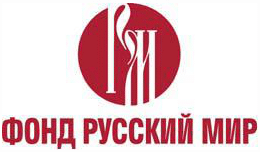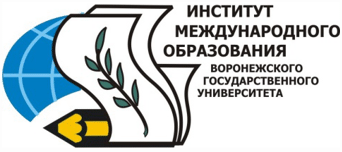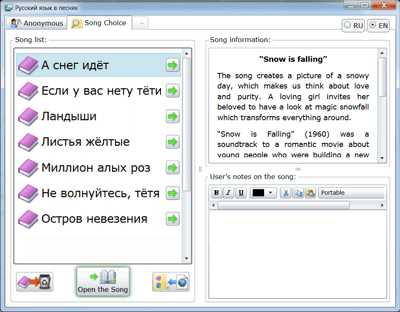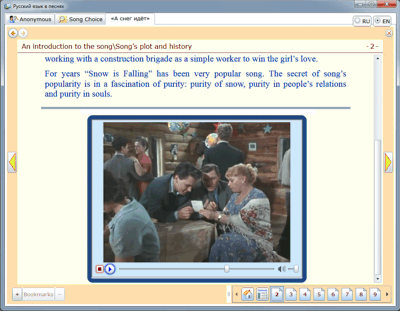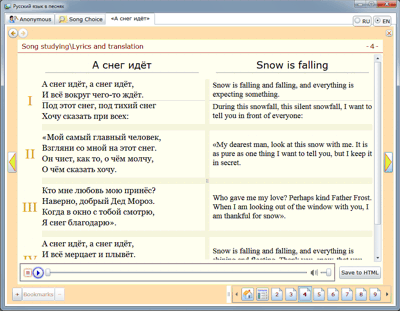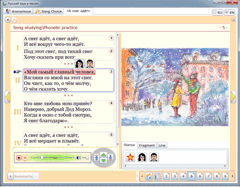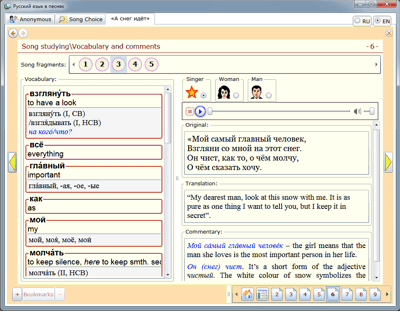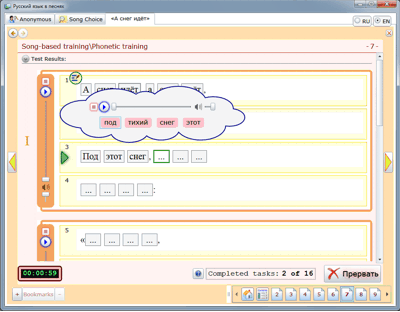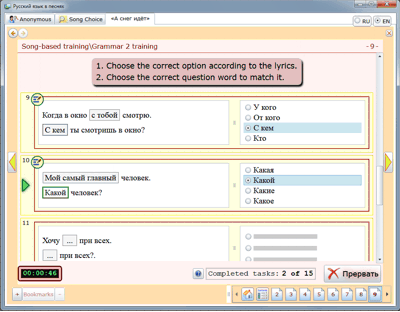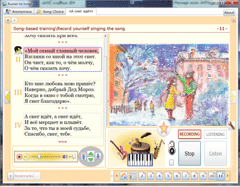To start working with the program “Russian via Songs”, do the following:
- Install Microsoft Silverlight plugin for your browser (if it’s not installed).
- Move to the “Installation” page.
- If Microsoft Silverlight isn’t installed on your computer or the current version is older than 5.0, you’ll see the banner of Microsoft Silverlight on the screen.
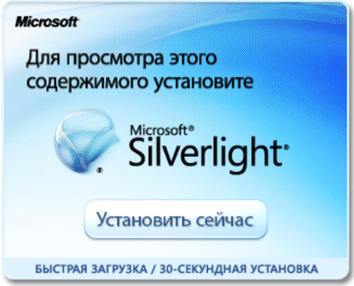
- Click on the banner and follow the instructions.
- After installing the Microsoft Silverlight plugin, on the page "Installation" you should see the banner of the program "Russian via Songs". If not, update the web page by pressing F5 (on the keyboard) or any other way.
- Note: You may also install the recent version of Microsoft Silverlight on your computer from the official site Microsoft:
- http://www.microsoft.com/getsilverlight
- Install the program “Russian via Songs” on your computer.
- If the current version of Microsoft Silverlight on your computer is 5 or higher, you’ll see the banner of the program “Russian via Songs” with the [Install] button on your screen.
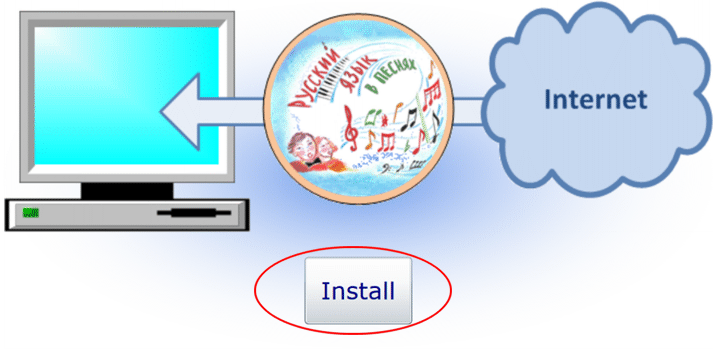
- Click the [Install] button and follow the instructions. After successful installation of the software, it will start automatically.
- You may enter the program under the anonymous login or create your own profile (as a new user).
- After you open the program, download the files from the server (total 16 files). Click on the [Load the songs from the server] button, select the songs you want to install from the list and press the [Start Download] button.
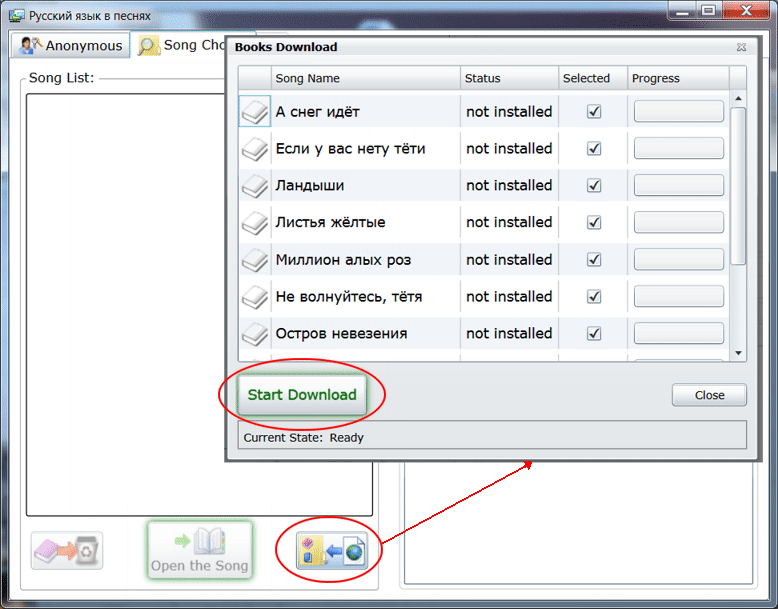
- Note: you must have Internet for downloading files with learning material. For further work with the program Internet connection is not required.
Manual
The program “Russian via Songs” consists of 16 modules; each of them contains the learning material for one of the popular Russian songs from Soviet times. The modules have a book-like structure. All downloaded modules are in the [Song Choice] tab of the application main window. From that window you may start working with the song/module you choose.
Inside the module, you are free to study the way you like. However, we recommend that you work with each song following the structure of each module.
Open a song from the list at the [Song Choice] tab and check out the following sections:
| An introduction to the song | ||
| Song’s plot and history | p. 2 | In this section you’ll learn general information about the song (its authors, performer, lyrics and history of creation) and watch a video. |
| About authors and singers | p. 3 | |
| Song Studying | ||
| Lyrics and translation | p. 4 | Here you can listen to the song, read lyrics and their English translation, and save them as HTML. |
| Phonetic Training | p. 5 | In this section you will listen to the song part by part. You can listen to each part either performed by a singer or read by an announcer. Please, pay attention to the pronunciation of separate words and phrases, as well as sounds at word joints. Listen, read, repeat! |
| Vocabulary and comments | p. 6 | The lyrics are divided into the parts, each of which provides relevant vocabulary, contextual meanings and extralinguistic commentary. |
| Song-based Training | ||
| Listening | p. 7 | Test your knowledge of the lyrics! Put the words in the correct order while listening to the song’s lines or parts. |
| Grammar Training | p. 8, 9 | Perform the song-based Grammar test that includes form choice and question formation tasks. |
| Vocabulary Training | p. 10 | Run the Vocabulary test based on the lyrics: fill in the proper word, choose the synonym, type in the missing words. |
| Recording your own performance | p. 11 | Now to the fun part! Record your own performance of the song. |
Appendix
SYMBOLS AND ABBREVIATIONS
| adv. participle | adverbial participle, form of the verb |
| comp. | comparative degree of adjective |
| diminutive of | diminutive form of the noun |
| only | the sign means, that only these forms can be used in this meaning |
| participle | participle forms of the verb |
| past | irregular Past Tense verb forms (but Present Tense forms are regular here) |
| pl. | plural form of noun |
| pl. Gen. | plural form of noun in Genitive |
| short f. | short forms of adjective |
| short f. of part. | short forms of participle |
| superl. | superlative degree of adjective |
| with prep.: | pronoun forms with preposition |
| и | “and” — both forms are possible |
| я form is not used | the verb doesn’t have 1st person singular form |
| (f) | feminine gender |
| (m) | masculine gender |
| (n) | noun |
| (adj) | adjective |
| I | the 1st conjugation verb |
| II | the 2nd conjugation verb |
| 1 | the 1st group of verbs of motion |
| 2 | the 2nd group of verbs of motion |
Pay your attention:
the order of the pronouns case forms is: Nominative, Genitive, Dative, Accusative, Instrumental, Prepositional.
For example:что-то, чего́-то, чему́-то, что́-то, че́м-то, о чём-то.
The verbs are presented as follows: first, infinitive of the verb’s form, from the song and then its aspect pair (imperfective – perfective).
For example:сказáть (I, СВ); скажу́, скáжешь, скáжут
/говори́ть (II, НСВ)
что? кому́?
The Russkiy Mir Foundation and Institute of International Education (Voronezh State University)implement this project.
